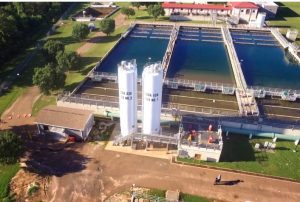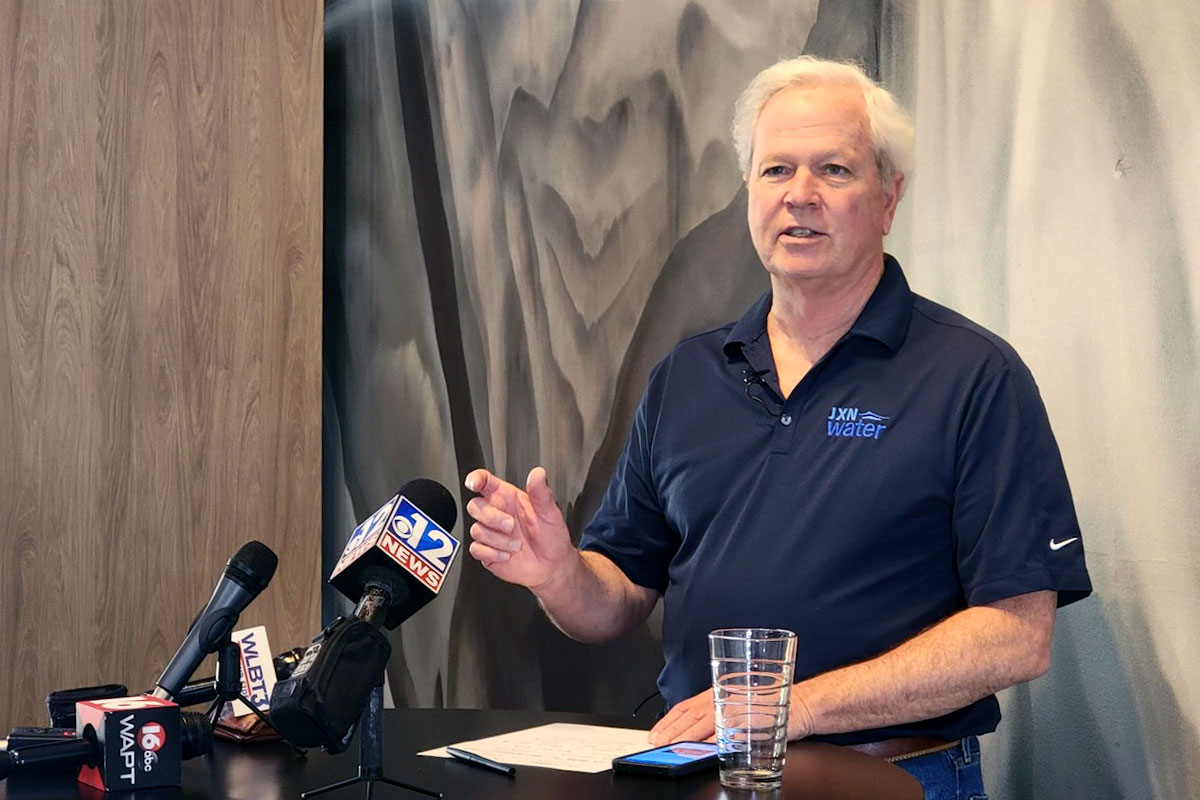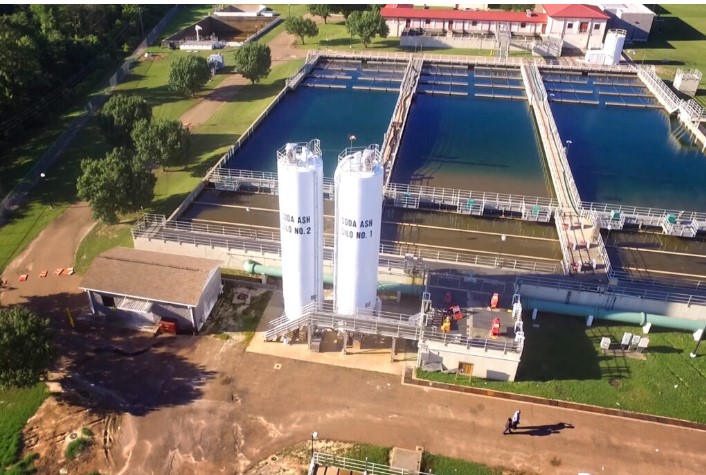By Nick Judin, Mississippi Free Press

The City restored water to Jackson residents within hours of the May 9, 2024, water outages instead of the days JXN Water leadership say it would have taken before the 2022 water crisis. Photo courtesy City of Jackson
Last Thursday, a storm shut down water production at Jackson’s O.B. Curtis Water Treatment Plant for the third time this decade so far. Across Mississippi’s capital city, water tanks drained and pipe pressure dropped, faucets trickling—first in South Jackson and then across the city.
But what followed was not the weeks-long outage of years past. Power was restored to O.B. Curtis in short order Friday morning, water production spun up, and within hours, Jackson’s water system was back to normal.
On Saturday, after one day of a mandatory boil water notice, tests showed the system was still all clear. After years of dysfunctional plant performance, O.B. Curtis has now weathered two challenges without prolonged disruptions in a matter of months—a far cry from its collapse in the late summer of 2022 that took weeks to repair.
Heavy winds from storms late on May 9 caused numerous power outages across the greater Jackson area. A switch at O.B. Curtis provides an alternative feed of power in the case of outages like Thursday night’s, but activating the switch is a manual process, and workers were not able to do so until early Friday morning after several hours of power loss at the facility.

“Probably as late as last fall—even winter—if we had had this same situation, recovery would be days, not hours,” JXN Water Interim Third Party Manager Ted Henifin said on Friday, May 10, 2024. Photo by Nick Judin
“By the time power came back on our pressure sensors were showing we were below the required 20 PSI in many parts of the distribution system; out of an abundance of caution, we issued that precautionary boil water notice citywide,” Ted Henifin, the federally-appointed manager for the Jackson water system, explained at a Friday morning press avail.
The lack of backup onsite power at O.B. Curtis is a problem that regulators have highlighted for decades. “Typically this two-feed system has worked very well,” Henifin said. “Entergy has (always) responded quickly to make that happen.”
But, like many problems at O.B. Curtis, the persistent need for a more permanent solution is finally coming to a close. “Resilient power for O.B. Curtis is one of the primary priority projects in the stipulated order,” Henifin explained, referring to the federal court order mandating improvements in the water system. “A crazy coincidence is that we got the final technical memo from (HDR) on Wednesday of this week.”
Soon the alternative feed switch will be manual, and two backup generators onsite will provide temporary energy independence for O.B. Curtis, preventing this issue from happening in the future. But the extensive cost of the project helps to explain why it never happened before: the price tag for everything needed tops $30 million.
Only months earlier, in mid-January, a cold snap struck Jackson, hitting the still heavily challenged distribution network hard. Amid panic over conspiracies about water shutoffs, Jackson’s water production facilities faced their most serious demand since the federal takeover that followed the 2022 water crisis, but withstood the challenge. O.B. Curtis maintained production of 60 million gallons of water per day during the cold snap.
System Monitoring Online
That Jackson experienced an outage last week, however temporary, is an illustration of the circadian rhythm of modern water systems. A nighttime loss of water production is especially problematic, Ted Henifin explained, because the period of highest demand for water comes as the city is waking up in the morning.
Without sufficient storage and production to meet the morning demand for water, the system drains, and eventually, the pressure in the pipes drops below 20 pounds per square inch. These are the conditions in which back siphonage can occur: When the pressure within the pipes is so low that raw, untreated groundwater can be sucked into joints and cracks in the subterranean water system.
But although the outage recalls the historic fragility of the Jackson water system, the quick recovery speaks to its strides toward functionality.
“Probably as late as last fall—even winter—if we had had this same situation, recovery would be days, not hours,” Henifin told this reporter. “And that’s the biggest difference.”
The culprit then would have been the dozens of major valves throughout the city’s distribution system—gateways that allow water to be diverted through the miles and miles of pipes. In the long years of slow decline leading to the failure of Jackson’s water system, dozens of these key valves were shut off during maintenance and never reopened. Some were forgotten about entirely.
One by one, JXN Water uncovered and reopened old valves, a strange archaeological task in a long-neglected system.

Workers from Littleton, Mass., helped to repair structures at the O.B. Curtis water plant in the weeks following the collapse of water production in December 2022. Photo courtesy MSDH
“We’d still have some of those closed valves,” Henifin said. “We hadn’t discovered all of them. So you’re pushing water for longer distances through circuitous pipelines to get to all parts of the system.”
Assisting the process of the system’s recovery are pressure monitors through the system, installed in the same push to map the network that required the rediscovery of Jackson’s numerous valves.
Previously, monitoring the system was an exceedingly ad-hoc process. Reports of pressure loss in various areas would be the warning signs of greater problems in the system. Now, Jackson’s water system is being monitored by a centralized system.
While such a system sounds like it could come with a substantial price tag, Henifin said the cost was effectively a pittance compared to the big-ticket improvements and debt relief that most of the federal money Congress approved in December 2022 is being spent on.
“It’s really not very expensive,” he said, “The monitors are $1,100 each—I think the overall cost to put it all together was … less than $100,000.”
No pressure monitors—one of the key reasons the City of Jackson understood so little about the changing conditions in its own water system on a daily basis—fixed, all for less than $100,000. This reporter asked Henifin why the City of Jackson had declined to install such a system in previous years. As is usual for questions that predate his tenure, Henifin laughed and cut his speculation short.
“It’s just another example of the chronic underinvestment over many, many years, for whatever reason. That leads to many things; it could have just been as much underinvestment in people and skills that they didn’t even know to ask for,” he said.
‘We’re in Recovery’
Now a year and a half into the federal takeover of the system, JXN Water is reporting significant progress in the sprawling task of righting the capital city’s drinking water facilities. Of 13 priority projects, five are complete: The first phase of an operations and management contract with Jacobs Solutions, a national engineering company that provides staffing services, the winterization of water production facilities, corrosion-control projects at J.H. Fewell Water Treatment Plant, an alternative emergency water-supply plan, and temporary chlorine system improvements at the O.B. Curtis Water Treatment Plant.
The task is far from complete, however. Improved corrosion control at O.B. Curtis—a perennial problem for the system, and the first that drew the attention of the federal government—is still ongoing. Numerous other improvements to O.B. Curtis, like the resilient power plan, are also underway.
And the biggest challenge of all remains the distribution system. Remarkably, in spite of JXN Water reporting the plugging of millions of gallons of leaks in the drinking water system, water production at O.B. Curtis remains near the same level it has been in the last decade: significantly more than the residents of Jackson could ever need, pointing to massive water loss throughout the system.
It should be the case one day that Jackson will only need roughly 17-20 million gallons of water a day, explained JXN Water Senior Strategic Communications Lead Ameerah Palacios. “This accounts for flushing, repairs, etc.,” she wrote in a March 1 email to the Mississippi Free Press, adding that it would also cover the typical water loss expected of a modern distribution system of around 16%.
Jackson still produces well over twice that amount every single day, meaning most of the finished water is still lost somewhere in the system—although the average water production does appear to be dropping
At Friday’s press briefing, Henifin acknowledged the progress Jackson has made and the long road ahead. “We’re not recovered. We’re in recovery,” he said. “We’ve got stable and good water going out constantly, but we still have a lot of work to do—investments in the system to make it resilient.”

